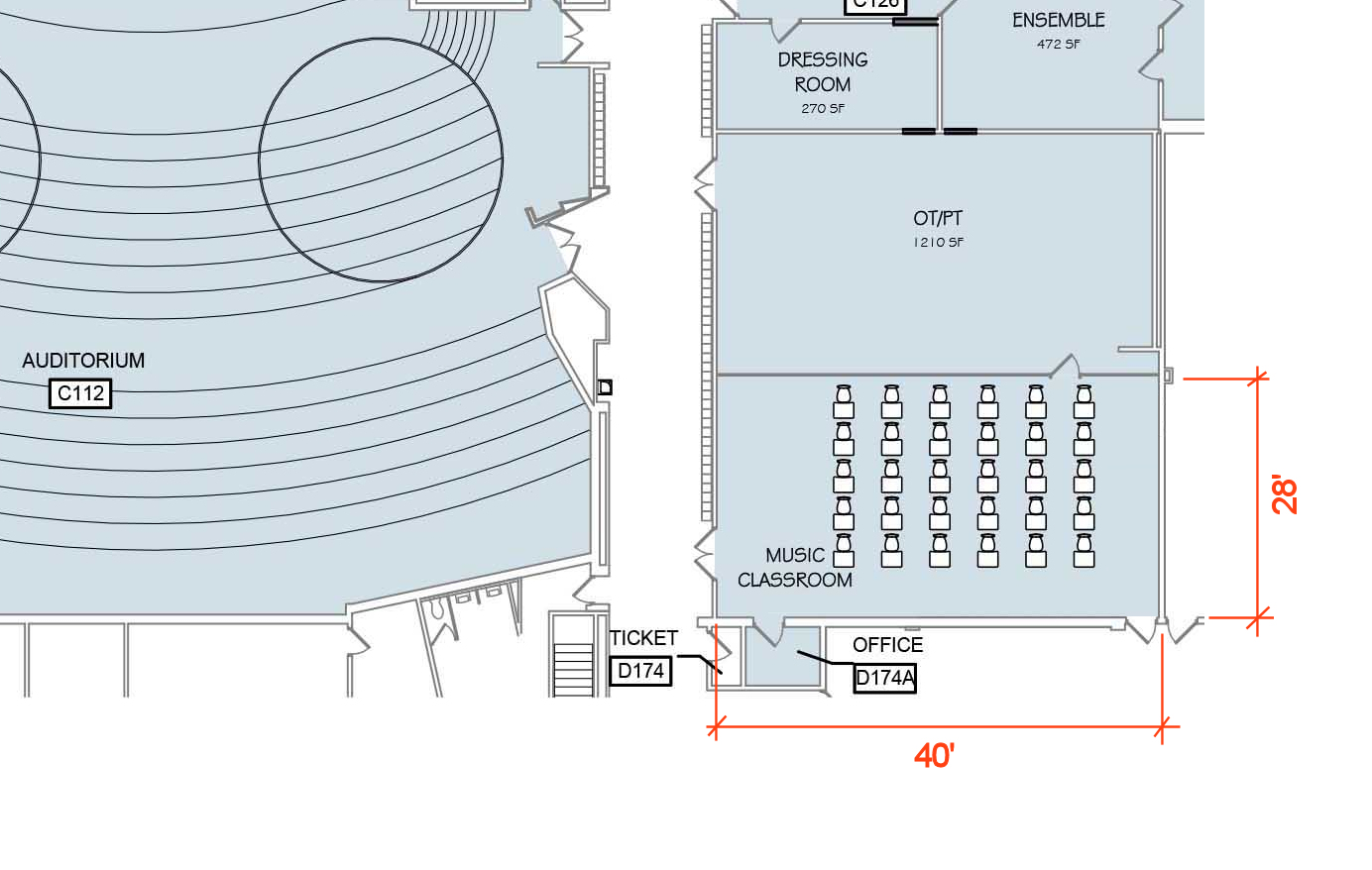Yesterday, I posted a partial floor plan, and I asked some questions to help you put some of what you have learned about codes to use. I think we could all benefit from the practice.
Spoiler Alert: If you want to look at the original post rather than skipping right to the answers (below), it is here.
Here’s the floor plan for a music classroom in a high school, and the assignment was to answer the questions below using any edition of the International Building Code.

Here are the questions, along with the answers (click the links for more info and code references):
A) What is the calculated occupant load of this classroom?
To calculate the occupant load of a room or space, you take the area and divide by an occupant load factor. The IBC lists these factors in a table, and the factor for educational classrooms is 20 square feet per person. The area of this room is 1,120 square feet (40′ x 28′), and the occupant load is 56 people (1,120 square feet / 20 square feet per person). Finding the occupant load is the first step to answering the other questions.
There were some questions about whether maybe an occupant load factor for assembly occupancies should be used, or whether the chairs should be counted as fixed seats. This building has separate rooms for the band and chorus, so I think this room is intended to be a classroom and would not be considered assembly. For a lecture hall or bleacher seating, the occupant load is calculated based on fixed seats, but I’m guessing the desks and chairs shown here are not actually fixed seats.
B) Are all 3 doors (2 singles and 1 pair) required for egress?
When the occupant load of a room is over 49 people, the room typically requires at least 2 egress doors. Very large occupant loads (500+) would require 3 egress doors or more, but with a load of 56 occupants, 2 exits would be sufficient (1 exit would not be sufficient for this occupant load).
There are 3 doors here and only 2 are required for egress. If more doors are provided for egress purposes, even if they are not required, then they have to comply with the IBC requirements (more on that here). I would not consider the doors to the OT/PT room to be provided for egress purposes from the music classroom, so the other two doors are sufficient for egress doors. One reader commented on the required distance between the two egress doors (1/2 the diagonal dimension of the room), and I will write a separate post about that.
C) Are the doors serving this room required to be outswinging?
The IBC requires doors that are serving an occupant load of more than 49 people to swing in the direction of egress (doors serving high hazard occupancies with any occupant load must also be outswinging).
D) Do the doors require panic hardware?
This school is an educational occupancy, and the IBC requires educational and assembly occupancies with an occupant load of 50 people or more to have panic hardware – IF the door is equipped with a lock or latch. I would assume that this music classroom would have locking hardware to prevent access, so the doors would require panic hardware, or fire exit hardware for doors that are fire rated. If the doors were not required to lock or latch, and if they were not fire doors, they could have push plates/bars and pulls, instead of panic hardware.
One reader asked about omitting the panic hardware on the inactive leaf of the pair, and only installing it on the active leaf. While the IBC does not specifically state whether one or both leaves would require panic hardware, the common interpretation is that both leaves should have panics. NFPA 101 is a little different, and could be interpreted to mean that only the required/active leaf would need panic hardware. To avoid problems in the field, I would specify panic hardware for both leaves.
Any questions? Thanks to everyone who participated!
Do you have an idea for an “Apply-It” post? Please leave it in the reply box!
You need to login or register to bookmark/favorite this content.






Ok I failed… but the lesson I learned is don’t trust the plans for fixed seating. Not seeing any other furniture made me think it was fixed seating. That and the fact I thought you would throw a curve ball at us as I would. let me give them a plan that makes you think it is over 50 and then point out it is one under.
EXCELLENT Training problem. I can see this being another continuing segment of your site Lori!!! Keep them coming!!
I think these exercises are a great idea. Keep up the good work.
Lori,
Concerning inactive leafs on pairs of doors, it is restricted by the following:
IBC 1008.1.9.4 Bolt Locks
“Where a pair of doors serves an occupant load of less than 50 persons in a Group B, F, or S occupancy, manually operated edge or surface-mounted bolts are permitted on the inactive leaf. The inactive leaf shall contain no doorknobs, panic bars or similar operating hardware.
4. Where a pair of doors serves a Group B, F or S occupancy, manually
operated edge-or surface-mounted bolts are permitted on the
inactive leaf provided such inactive leaf is not needed to meet egress
width requirements and the building is equipped throughout
with an automatic sprinkler system in accordance with the Section
903.3.1.1. The inactive leaf shall contain no doorknobs, panic bars or
similar operating hardware.
Hi Jeffrey –
Those exceptions address manual flush bolts, but someone could make the argument that if the active leaf accommodates the occupant load, and the inactive leaf is only there for the movement of equipment or for aesthetics (or for some other reason), then the active leaf could have panic hardware and the inactive leaf could have automatic flush bolts which would retract as soon as the inactive leaf is opened. This is not how I would handle this application, but I have a response from NFPA staff which indicates that they interpret NFPA 101 to mean that this would be acceptable.
– Lori
Hi Lori,
My Question is on part B, do the two separate exits need to be at least two Single openings, or can a pair opening suffice?
Hi Ben –
The pair only counts as one of the exits.
– Lori
“The IBC requires doors that are serving an occupant load of more than 49 people to swing in the direction of egress (doors serving high hardware occupancies with any occupant load must also be outswinging).”
“High hardware occupancies” – that’s a new term on me. Would you explain plese.
Hi Craig –
That was a typo – it should have said high hazard occupancies (and now it does). Sorry about that – I am solely responsible for this site but I also do a lot of other things so sometimes my brain doesn’t keep up with what I’m typing. Luckily I have readers who point out my mistakes so I can fix them.
– Lori
that was fun thanks
Lori
Would you provide a post as to when vision lites are required in a door.
Hi Tony –
Vision lights are not required by code for most locations – the exception that comes to mind is cross-corridor doors in health care (more about that here: https://idighardware.com/2017/02/wwyd-frosted-glass/). For schools, it would usually be the Board of Ed standards that dictate whether a light is required, and those standards vary widely from one area to the next.
– Lori
– Lori
this exercise is extremely similar to one I am dealing with at the moment and will be addressing in an upcoming project to resolve the issue (hopefully). Might be a candidate for Apply It. What would I have to do/provide?
Hi Michael –
If you can send me a floor plan and description of the situation by email (lori.greene@allegion.com), I’ll put it in the file for a future post. Thanks!
– Lori